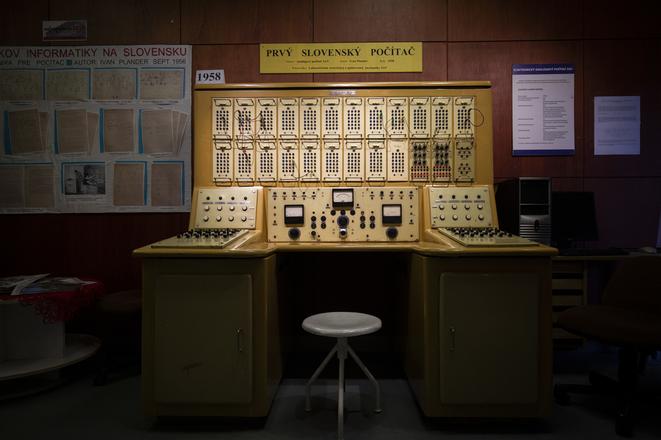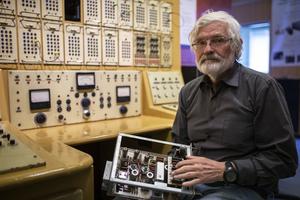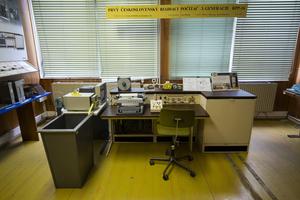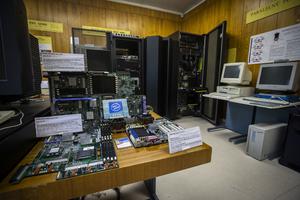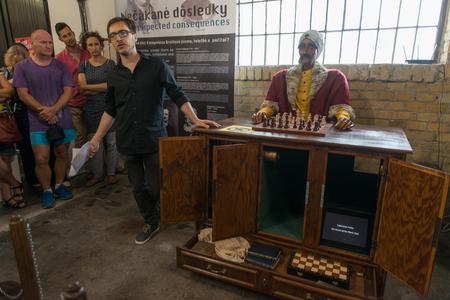Nowadays, the quite commonly used 256 GB micro SD memory card has the same capacity as 800,000 kilometres of paper-punched tape used to have in the 1970s. With such long tape, it would be possible to bind the globe as much as 20 times. The tape is just one of about 600 exhibits of the computer museum located on the campus of the Slovak Academy of Sciences (SAV) in Bratislava’s Patrónka.
“The idea of this exhibition is not just nostalgia for old computers,” said Martin Šperka, head of the exhibition, who himself was involved in the past development of computing in Slovakia. “It very well demonstrates the development of computers and computer technology in Slovakia and in the world – from vacuum tube machines to smartphones with complex systems on a chip or supercomputers with many powerful microprocessors.”
First Slovak computers
The most precious exhibits are computers developed by Slovak specialists and in Slovakia.
“The first Slovak computer was developed by mechanical engineer and radio amateur Ivan Plander,” said Šperka.
It was an analog computer and it was put in operation at SAV in 1958. It was used, for example, to calculate the mechanical properties of cars. SAV experts used it for calculations in damping an incubator when transporting babies.
The weakness of analog computers, however, was their lack of accuracy. At that time, analog computers started to be replaced by accurate digital computers. Plander, the most successful expert in this field in Slovakia, decided to build such a computer as well.
The result was the computer RPP-16, developed at the Institute of Technical Cybernetics (ÚTK) SAV between 1965 and 1973 as a third generation control computer. When designing this computer, Plander and his colleagues used as inspiration the best American control computers. They tried to mimic their features on a computer of their own design.
Computer museum
The official name is the Permanent Exhibition of Computing History in Slovakia and it is part of the Computing Centre of the Slovak Academy of Sciences (SAV)
It presents the subjects and documents related to the research, development, production and application of information and communication technologies in Slovakia and the world
It is located on the SAV campus on Dúbravská Cesta in the Bratislava’s district of Patrónka
It is usually open from 10:00 to 15:00 during working days.
For groups bigger than five people and after 15:00 it is necessary to arrange a visit in advance by sending an e-mail to the head of the permanent exhibition, Martin Šperka, martin.sperka@savba.sk or by phone 02/3229 3131
Admission is free
More at www.vystava.sav.sk/english
How to get here: The main (but not best) entry is directly from Dúbravská Cesta (approximately 150 metres from the IBM garages on the way to ŠVU (School of Applied Arts). Ring the bell at the gate. Another entry is from the SAV campus, the one-floor building behind the Computing Centre (Výpočtové stredisko) staircase behind the entry to the
Computing Centre and 50 metres to the right (ring the bell).
It is also possible to arrange the visit of the most powerful computer in Slovakia, supercomputer Aurel
Its laboratory specimen was laid out on grids spread over about 10 desk tables, as it gradually evolved and its individual parts were activated. It was a small technical miracle that a computer built in such a way worked for several years.
After preparing this computer for production at the Research and Development
Centre in Žilina, a total of 214 computers in various modifications were manufactured in the Tesla Námestovo plant. They were deployed in agriculture, the energy sector, mining, industry, schools, and research institutes. One of them has been reconstructed for the computer museum, but since it lacks several parts, it is not functional any more.
Reverse engineering
Czechoslovakia was relatively good at developing analog computers and though the RPP-16 was not a copy, but the result of genuine development by Slovak IT experts, lagging behind the development in the US by about only five or six years. Then Czechoslovakia and the other Eastern Bloc countries began to gradually lag behind further.
“Lagging behind the West began in the 1950s, when cybernetics was considered a bourgeois pseudoscience and the Eastern Bloc countries did not pay enough attention to it,” said Šperka.


